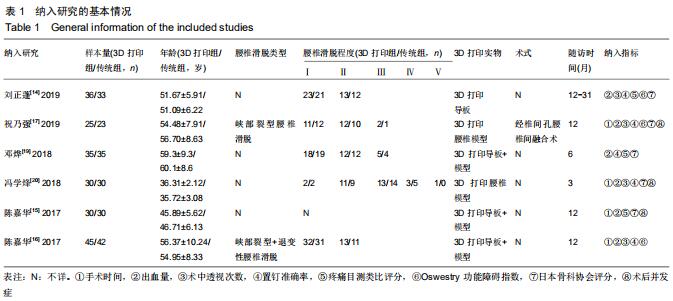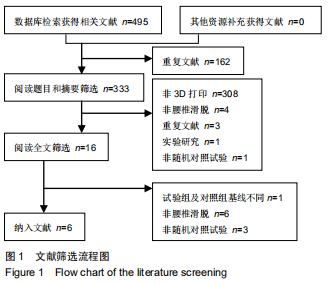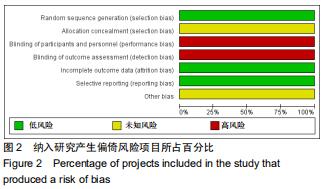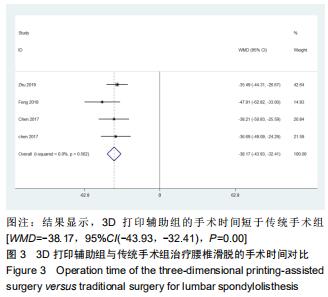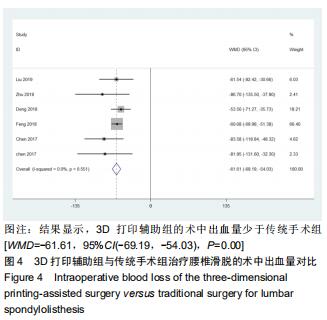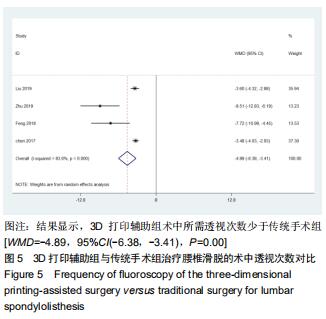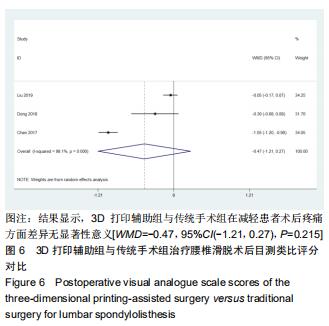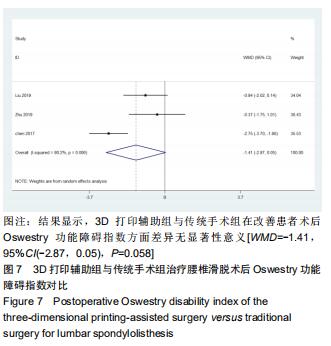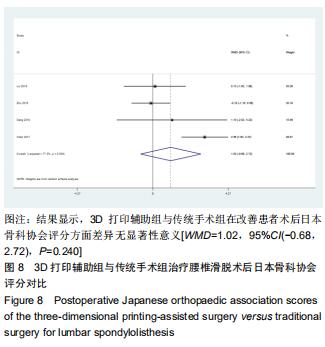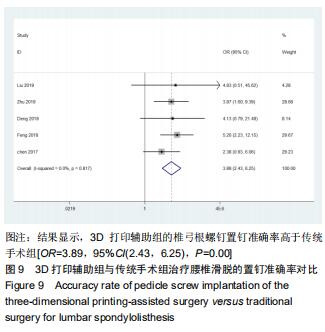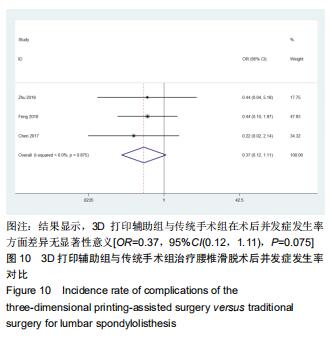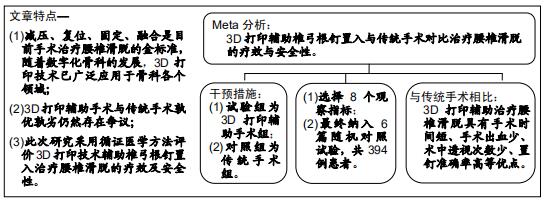中国组织工程研究 ›› 2020, Vol. 24 ›› Issue (30): 4898-4904.doi: 10.3969/j.issn.2095-4344.2829
• 骨与关节循证医学 evidence-based medicine of the bone and joint • 上一篇 下一篇
3D打印辅助椎弓根钉置入与传统手术治疗腰椎滑脱的Meta分析
周俊德1,范智荣1,苏海涛2,彭嘉杰1,周 霖1,洪伟武1,黄晖达1
- 1广州中医药大学第二临床医学院,广东省广州市 510405;2广州中医药大学第二附属医院骨科,广东省广州市 510006
Comparison of three-dimensional printing-assisted pedicle screw placement and traditional surgery for lumbar spondylolisthesis: a meta-analysis
Zhou Junde1, Fan Zhirong1, Su Haitao2, Peng Jiajie1, Zhou Lin1, Hong Weiwu1, Huang Huida1
- 1Second Clinical Medical College of Guangzhou University of Chinese Medicine, Guangzhou 510405, Guangdong Province, China; 2Department of Orthopedics, Second Affiliated Hospital of Guangzhou University of Chinese Medicine, Guangzhou 510006, Guangdong Province, China
摘要:
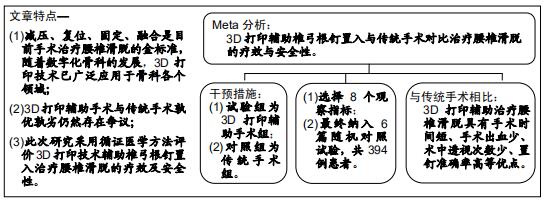
文题释义:
3D打印:是一种综合应用数字化建模、材料、化学、信息化等前沿技术,实现快速成型的技术,目前已广泛应用于骨科不同领域,如手术导板、个体化模型、假体内置物、生物打印等,具有小批量、个性化、精准化等优势。
腰椎滑脱:是指相对下位椎体,上位椎体全部或部分滑动、移位的病理过程,临床上常导致腰痛及下肢疼痛、麻木或无力等马尾神经症状。保守治疗无效的患者需行手术治疗,该手术难点在于滑脱椎体椎弓根位置的确定,传统手术依靠二维X射线片、CT重建等方法确定椎弓根位置,很大程度上依赖于医师经验,无法进行可靠准确定位,置钉错误率及并发症发生率较高。因此,对腰椎滑脱患者术前制定个体化的手术方案设计有助于提高疗效,降低手术风险。
背景:随着3D打印技术的发展,其在脊柱外科已得到广泛应用。但目前3D打印辅助手术治疗腰椎滑脱是否比传统手术有优势尚存争议。
目的:系统评价3D打印辅助手术和传统手术在治疗腰椎滑脱中的疗效与安全性。
方法:检索中国期刊全文数据库(CNKI)、万方数据库(Wanfang)、中国生物医学文献数据库(CBM)、维普(VIP)、PubMed、Cochrane Library、Embase、Web of Science等中外文数据库,检索为从建库至2019-11-16,收集3D打印技术应用于腰椎滑脱患者的随机对照试验。按照事先制定的入选与排除标准筛选文献,逐一评价纳入研究的质量,提取有效数据,采用Stata 11.0软件进行Meta分析。
结果与结论:①最终纳入6篇随机对照试验,共394例患者,其中3D打印辅助组201例,传统手术组193例;②Meta分析结果显示,3D打印辅助组在手术时间[WMD=-38.17,95%CI(-43.93,-32.41),P=0.00]、术中出血量[WMD=-61.61,95%CI(-69.19,-54.03),P=0.00]、术中透视次数[WMD=-4.89,95%CI(-6.38,-3.41),P=0.00]、椎弓根钉置钉准确率[OR=3.89,95%CI(2.43,6.25),P=0.00]方面显著优于传统手术组;③但2组在术后目测类比评分[WMD=-0.47,95%CI(-1.21,0.27),P=0.215]、Oswestry功能障碍指数[WMD=-1.41,95%CI(-2.87,0.05),P=0.058]、日本骨科协会评分[WMD=1.02,95%CI(-0.68,2.72),P=0.240]、并发症发生率[OR=0.37,95%CI(0.12,1.11),P=0.075]方面差异无显著性意义;④综上所述,腰椎滑脱修复术中应用3D打印技术具有手术时间短、手术出血少、术中透视次数少、置钉准确率高等优点。
ORCID: 0000-0003-3414-8049(周俊德)
中国组织工程研究杂志出版内容重点:人工关节;骨植入物;脊柱;骨折;内固定;数字化骨科;组织工程
中图分类号:
